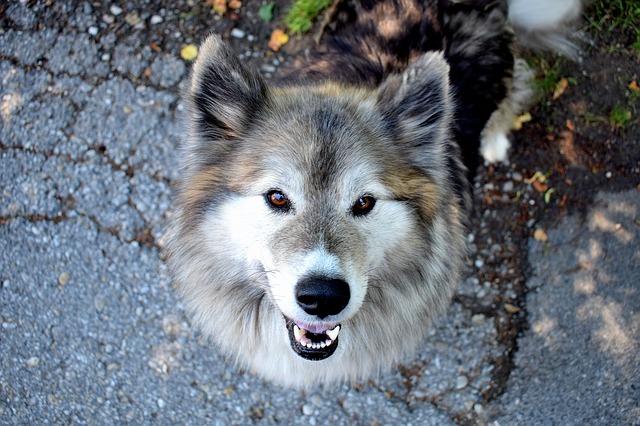From being abandoned by people they thought they could trust to surviving abuse and neglect, adopters can’t always relate to the trauma and obstacles their rescue dogs endure. Some dogs face each new challenge and path in life with optimism and courage, but others learn through past experiences to be shy and fearful. Even after making it out of the shelter and being adopted by a loving family, a lack of confidence can interfere with a rescue dog’s ability to fit in to a new life.

Signs of Low Confidence
A lack of confidence in dogs manifests in multiple ways. Cowering and crying in response to a situation are obvious signs the dog is uncomfortable. They react similarly to people in that they shutdown emotionally or practice avoidance behaviors to get away from whatever the problem is.
On the opposite side of the spectrum, some dogs resort to aggression. A rescue dog that lunges, barks, and growls at a specific stimulus is more likely afraid than angry. Lashing out is a defense mechanism, and their forceful show of bravado is actually a mask to their fear and apprehension. Victoria Stilwell says,
“The root of most aggressive behavior is fear. Combine fear with a situation where a dog has not been raised and trained humanely, and the result is often a disastrous cocktail of fear aggression.”

Whether your dog displays their insecurities through whining, cowering, running away, or fear aggression, their lack of confidence is a hurdle they can’t jump on their own. It could be something specific triggering their insecurities or a general feeling of vulnerability. Either way, the missing ingredient is confidence. It’s a dog owner’s responsibilities to help their pet overcome insecurities.
Here are a few ways you can boost your rescue dog’s confidence.
1. Prioritize Basic Obedience Training
Dogs may be notorious for their mischievous ways, but they’re actually the most comfortable when there are clear rules to guide them through life. Rules mean predictability, and knowing what’s expected of them can help stave off feelings of fear and anxiety. Whether your rescue has spent time in a home or is coming to you after years on the street, treat them as if they’ve never been trained before. Start with the most basic lessons, like “sit” and name recognition. Whether they fly through the lessons with ease or need more time to understand expectations, never use punishment-based training methods. Whole Dog Journal writes
“Nothing can destroy a timid dog’s confidence faster than the application of a verbal or physical punishment; this will convince him he’s right to think the world is a scary and unpredictable place.”
Positive reinforcement training will show your dog good things happen when they behave in a specific way. Instead of breaking them down when they do something wrong, build them up when they do something right. Dog trainers and behaviorists recommend positive reinforcement for all dogs, and it’s especially useful for insecure rescues. It shows them they can be in control to bring about positive scenarios.
2. Commit to a Daily Routine
Another way to make the environment more predictable is to establish a daily routine. Routines teach dogs structure and stability. Dogs like to know what’s going to happen when, and that simple knowledge boosts their confidence in daily activities. The world is no longer a mystery when they know what to expect, and they go about their routine knowing they’re safe.
When setting up your routine, commit to a schedule you’ll be able to follow on a regular basis. If you already have a personal way of doing things, it’s easy to start incorporating your pup. Serve their meals at the same time you regularly eat, commit to playtime every day during lunch, walk when you get home from work, and make bedtime a specific time. Your pup won’t particularly care what order things happen as long as they happen the same way everyday. It’ll take at least a few weeks for your dog to trust the routine and feel confident in following it.

3. Provide Quiet Spaces
As part of the family, the dog should have a place he can go that’s entirely his. When things get scary and his emotions get the best of him, he can retreat to his special spot to calm down and relax. The spot could be a kennel in a back bedroom or a dog bed in the corner of the room. It should be comfortable and quiet, and most of all, be somewhere no one can bother him. Encourage family to leave the dog alone when he goes to his “safe place” and block other family pets from invading.
Some dogs actively seek seclusion even when they don’t have a designated area. If you frequently find them under the bed or behind the sofa, consider that their plea for personal space. Being around people and scary situations can be overwhelming, and you can’t expect a rescue to adapt to their new environment all at once. Time alone to decompress is essential for emotional well-being. It’ll recharge their batteries and help them face their insecurities.
4. Use Unstructured Play
Playing is a way for dogs to exercise and let off steam, and it can also be used to teach confidence in rescue dogs. If your pup likes to fetch, tug, or wrestle but shuts down in certain situations, encourage them to play when they’re feeling afraid. Behaviorists call it counter conditioning, and it’s all about associating emotions to specific situations. Good Dog Tips says,
“When a pet is showing an undesirable response (barking, lunging, growling, or jumping etc), that response is usually associated with an underlying emotional state that is also undesirable. To help the pet respond in a different way, it is useful to change the animal’s association with the stimulus – the cause of the emotion – and hence, the underlying emotional state.”
If your dog is afraid of children, start in a spot that’s close, but not too close, to a group of children playing. Make sure your dog notices the children. Before they give in to fear, distract them with their favorite version of unstructured play. When they’re happily playing with you even with their perceived threat nearby, you know you’re making progress. The goal is to gradually get closer as your dog starts relating children to fun and games instead of scary experiences.

5. Introduce Confidence-Boosting Games
An easy confidence-boosting game to teach your dog is “target.” Your dog will think it’s all about getting tasty treats, but more importantly. it teaches confidence and control. For beginners, the target is your hand held directly in front of them. Teach the dog that every time they press their nose to your hand, they win the game and get a treat. As they get better, move your hand farther away so they have to walk, jump, and climb over things to reach the target. The challenge round is getting them to touch other objects—like a sticky note stuck to the wall.
When your pup is feeling especially nervous or is recovering from a scare, start playing the game. The feeling of “winning” the game will overshadow insecurities and teach them they’re capable of making good things happen. A lack of confidence often comes from feeling they don’t have control over what’s happening. A simple game like target teaches focus and appropriate action to trigger an anticipated result. Other confidence-building games and activities include “find it” and getting them involved with agility, lure coursing, nose work, and other structured canine sports. Succeeding in one thing builds confidence needed to overcome other obstacles.
The most important thing to remember when raising a rescue dog with low levels of confidence is to be patient and compassionate. Change takes time, and it’s important to look for gradual improvements and not immediate results. Be understanding and positive, and your pup will learn to trust you and be open to more experiences.

